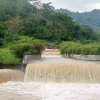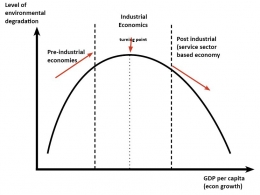Climate change is no longer an issue that can be ignored and it must be dealt with sooner than later. Since the industrialization era, levels of the atmospheric greenhouse gases (GHG) have been increasing exponentially. According to the Intergovernmental Panel on Climate Change (2014), both economic and population growth plays a major role in the release of CO2, NO2, methane, and other hazardous GHG, causing global temperatures to rise. Thus, in order to suppress emissions that are detrimental to ecological and physical sustainability, sectors performing activities that contribute vastly to pollution, such as the energy sector, must make large-scale accelerations towards a green culture (Ritchie and Roser, 2020).Data from the World Resource Institute (2020) show that 73.2% of global GHG emissions is generated from the energy sector. Moreover, the 2019 Southeast Asia Outlook states that overall electricity demand of ASEAN countries increases at a 6% rate every year, which is considered to be one of the fastest growth in the world. As economic growth is based on the rise of production, energy consumption would rise inevitably in emerging economies (Anwar, et al., 2020).
Members of ASEAN have now set regional targets for renewable energy (RE) consumption that must be reached within a certain time frame to eliminate fossil fuels and decarbonise the energy system in the near future (ASEAN Centre for Energy, 2021). Derived from the name itself, RE is energy that is collected from natural sources that constantly replenishes and is inexhaustible in duration (NRDC, 2018). This writing will discuss the current condition of ASEAN’s energy sector, MRE adoption potential, trade-off, and policy recommendations to increase RE capacity.
ASEAN’s Energy Sector
There is an imminent need for member states to not only reduce carbon emission but increase RE share of total primary energy supply (TPES); seeking for investors to bring low emission technologies is needed for long-run sustainability. The abundance of natural resources accessible in the 10 countries makes ASEAN standout as an investment opportunity, thus member states require a large source of energy to process the natural capital (Anwar, et al., 2020). With energy being the foremost device for economic growth as it is the main input of production, it plays a major role in generating jobs, commerce, agricultural produces, and other outputs, thus increasing the Gross Domestic Product (GDP) of the country, along with the living standards of the people (Anwar, et al., 2020). Therefore, renewable energy would be the best viable method to reduce emissions while still ensuring a secure electricity supply needed for development (Erdiwansyah, et al., 2019).
Although Southeast Asian countries have been increasing their renewable energy capacity, it is still highly dominated by traditional or first-generation biofuels. The traditional method of processing biofuels normally uses food crops as feedstock such as sugarcane, palm, and cassava, that will eventually be converted into bioethanol through biochemical processes that involve a lot of heat (Subramaniam, et al., 2021). Thus, this renewable energy source is often criticized as they have yet to result in environmental sustainability due to the harvesting method of the raw materials that may affect food supply and biodiversity loss, along with the hazardous chemical output.
While the production of advanced biofuels in more developed countries convert waste to energy, required equipment to do so is still costly and should not be an investment priority to increase modern renewable energy (MRE) consumption (Vidinopoulus, et al., 2020). ASEAN countries must now focus on MRE sources that are available in the region due to geographic factors such as wind, hydro, solar, and geothermal, instead of allocating all sustainable energy budgets on developing biomass or biofuel.
MRE potential for ASEAN countries
Before focusing on investments, Southeast Asian countries have been focusing on increasing MRE supply shares. As of 2017, Indonesia, Thailand, Malaysia, and Vietnam account for 36%, 20%, 13%, 12% of ASEAN’s TPES, respectively. From the total TPES of ASEAN, only 7% of it is sourced from modern renewable energy, while 18% of it is composed of biomass and 75% of fossil fuels as shown in figure 1. The difference between MRE and biomass value shows that the current uptake of infrastructure for MRE is still low across Southeast Asia (Vidinopoulos, et al., 2020).

Considering that the target set by ASEAN to ASEAN Energy Outlook (AEO) is to reach a 23% RE share of TPES (excluding biomass) by 2025, reduction of nonrenewable energy plans involving biomass must be reevaluated as it is said to be more dangerous than fossil fuels. Indonesia’s program to increase palm biodiesel production to boost RE supply has been criticized by many international bodies, but as seen from figure 1, they are reliant on biomass production. Due to the geographic structure of Southeast Asian nations that houses an abundance of natural resources, there is a high RE capacity that can be explored and utilized by members to increase RE share without biomass.

According to 2019 data presented in figure 2, hydro energy has a significant potential in ASEAN countries; Vietnam’s hydro capacity share constitutes for 60% of the total national MRE sources share or 18 gigawatt (GW) and Laos is the first country to export hydroelectricity to Thailand and has set a target to produce 24 GW to use as primary energy source. Resources from the Mekong region will highly contribute to meeting the demand of hydroelectric energy that can also be exported. On the other hand, although becoming more apparent in the Philippines, Vietnam, and Thailand, wind has the smallest potential in Asia due to the sizable amount of ground needed. However, the latest policy scenario for 2016 estimates that wind power will be the fastest-growing electricity technology as countries implementing it have been intensely finding investors to fund and develop needed infrastructure (Erdiwansyah, et al., 2019).
Moreover, geothermal generated energy has been produced by the Philippines and Indonesia; power plants are very significant in increasing MRE capacity in both countries. Indonesia has passed aggressive policies to attract investors and encourage them to explore areas that have previously been restricted but are now opened in order to reach the 29 GW target. The Philippines has also created a new policy scenario to increase capacity. However, the rise in geothermal energy is minimal due to the high cost needed for exploration purposes and difficulty competing for land demanded for coal and solar energy power plants (Erdiwansyah, et al., 2019).













